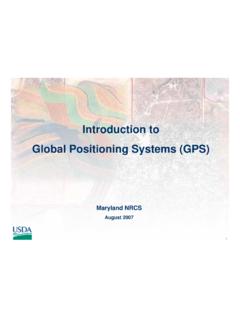Transcription of static gnss survey methods
1 Questions or comments please contact Page 1 Version January 19, 2018 static GPS/GNSS survey methods Manual Ian Lauer (Idaho State University) This document is a practical guide to field methods for static positioning systems. It does not cover positioning computation or theory, but is focused on field-based application of survey systems. This guide is intended for both instructors and students in its current form and may include asides of technical material targeted toward advanced users. Table of Contents Note on GNSS and GPS 1 1. introduction to static GPS/GNSS .. 2 Rapid static survey .. 2 static Surveys .. 4 Continuous Surveys (Semi-permanent to Permanent Stations) .. 4 2. Equipment .. 4 Antennas .. 4 Receivers .. 5 Power and Batteries.
2 5 Data Management, Storage, and Initial Settings .. 6 Tripods, Monuments, and Distance Measurement .. 7 3. Field Workflow: General .. 7 Site Analysis .. 7 Preparation and Logistics .. 9 4. static Field Setup .. 9 5. Data Processing .. 12 Data downloading and backup .. 12 Data formats .. 12 Data processing .. 13 Data archiving and data access .. 15 Note on GNSS and GPS Terminology GPS or GPS/GNSS will be simplified to GNSS herein. GPS, Global Positioning system , is the most commonly used system in the United States but is being complemented by a growing number of systems from international organizations. GNSS, Global Navigation Satellite Systems, refers to the various active satellite constellations including GPS (USA), GLONASS (Russia), Galileo (EU), BeiDou (China), and others.
3 static GPS/GNSS survey methods Manual Questions or comments please contact Page 2 1. introduction to static GPS/GNSS static GNSS surveys deliver the highest-accuracy positions available in a system , which occupies a point for longer periods of time than kinematic systems. static systems include a range of survey styles from rapid static surveys to continuously operating stations, such as CORS and PBO sites. The equipment setup varies significantly, depending on how long the site will be operational, which could vary from 15 minutes to several years. For the practicality of this field module, instructional material will focus on surveys ranging from rapid static to semi-permanent installations. Continuously operating permanent stations require many of the same techniques as other static systems, but require a level of precision and detail in their installation and processing that is beyond the level of this course.
4 static surveys rely on long occupation times to produce high-accuracy positions, and the details of their setup will vary to reflect the quality of measurements required. A static survey typically consists of a single receiver and antenna combination, which individually records satellite observations that are post-processed using a variety of techniques to receive a position. The precision of the position is a function of the length of survey and also the precision of the mounting and monument system used. static surveys require much more stable and precise mounts than kinematic surveys. A typical mounting system ranges from a range pole and bipod for rapid static occupations to anchored rods with direct antenna mounts for permanent surveys. Rapid static survey Rapid static surveys use shorter occupation times to collect a moderate number of points.
5 They do this by occupying a given point for a longer period of time than most kinematic surveys but much less than regular static surveys (Section below); typically, rapid static surveys are 15 minutes to 2 hours. A static survey is advantageous due to the simplicity of its setup, using a single antenna and receiver combination that has half as many components as a kinematic setup. This configuration is also necessary when radio communications or baseline distances for a survey exceed the capability of a kinematic design. However, static surveys typically have reduced accuracy compared to a kinematic survey of the same occupation time. Rapid static surveys also rely on proximity and availability of CORS or IGS stations for positional corrections. A map of the US with coded potential quality of CORS corrections can be found on the OPUS page Rapid static surveys are typically conducted by surveying monument locations and then post-processing positions in the lab.
6 First, monuments are established for any point, which will be reoccupied, such as measuring change or movement. Then the antenna is placed over the monument using a stable mount. The antenna records for the necessary occupation time and is then removed and taken to the next point of the survey . When the survey is complete, data is downloaded from the receivers, transformed into a RINEX file, and processed using proprietary software or a service such as OPUS (Online Positioning User Service). Processing through OPUS follows a similar style to PPK (post-processed kinematic) surveys such as in High-Precision Positioning with static and Kinematic GPS/GNSS, Unit 2: Kinematic GPS/GNSS methods ( ). static GPS/GNSS survey methods Manual Questions or comments please contact Page 3 Figure 1.
7 An example of a rapid static survey . The antenna is mounted on a bipod centered over a monument pin in the ground. This allows the antenna to remain stable over the occupation time (15 min in this case). Antenna mounts depend on the stability of the survey needed, with tripod, tribrach, and fixed mounts in ascending levels of stability. (Photo: Ian Lauer) Table 1. Advantages and disadvantages of different types of GNSS surveys survey Type Advantages Disadvantages Real-time kinematic (RTK) Real-time corrected positions in a known coordinate plane. Able to navigate to and compute geometries of data points in the field Significantly increased equipment cost and logistics. Must have radio connection between base and rover. Must set up base on a known position to use advantages Post-processing kinematic (PPK) Reduced logistics, cost, and complications.
8 Sufficient for most nonengineering-type surveys Corrected data is typically not available until processed. Necessary to set up base at benchmark or fix its location later Rapid static Reduced equipment expense and complication compared to PPK. Local base stations not necessary Requires longer occupation times up to 2 hours, with fewer potential measurements. Lower accuracy than RTK or PPK static Higher precision than rapid static , less equipment than RTK or PPK Requires long occupation times to reach similar accuracy to RTK or PPK. Requires more precise mounting and metadata collection than RTK, PPK, and rapid static Continuous Highest possible precision and accuracy (mm) Requires complex infrastructure, precision mounting, and very long occupation times. static GPS/GNSS survey methods Manual Questions or comments please contact Page 4 static Surveys static surveys offer the second highest precision of static surveys by occupying a single location for occupation times ranging from 2 to 48 hours.
9 When processed through OPUS, static surveys have a maximum accuracy of ~1 2 cm, depending on the quality and length of data collection. This is most comparable to accuracies achievable by PPK systems with long baselines, but in general PPK surveys are recommended if a local base station with short baseline is possible. static surveys are conducted and processed in the same way as a rapid static survey , but typically use higher-precision mounts and more equipment, such as large batteries, solar panels, and equipment enclosures to support the GNSS receivers during the length of the survey . The amount of equipment needed increases with increased occupation times. See Section for advice on batteries and length of surveys with some known hardware configurations.
10 Continuous Surveys (Semi-permanent to Permanent Stations) Semi-permanent to permanent surveys involve extended deployment of a station beyond 48 hours and potentially for many years. The advantage of a permanent survey is continuous data collection, which enables high-precision (mm-scale) positioning and the potential for monitoring an area beyond what is practical for a single field deployment. These installations require significant knowledge in geodesy and processing techniques, which are not included in this guide. However, field techniques for site selection, logistics, installation, and execution are similar and can be applied for the whole range of applications. In general, the additional hardware requirements of permanent installations include precision mounting devices, extended battery banks, and solar panels or other auxiliary power charging units.














